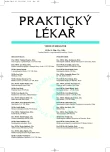A cure of severe form of haemophilia A by liver transplantation
Authors:
J. Charvát 1; P. Vychodil 2; M. Adamec 3; P. Trunečka 4; P. Ďulíček 5; I. Smrčková 1; L. Pagáčová 1
Authors‘ workplace:
Úsek laboratorních metod, IKEM, Praha
vedoucí doc. MUDr. Antonín Jabor, CSc.
1; Klinika anesteziologie, resuscitace a intenzivní péče IKEM, Praha
přednosta MUDr. Eva Kieslichová
2; Klinika transplantační chirurgie IKEM, Praha
přednosta doc. MUDr. Miloš Adamec, CSc.
3; Klinika hepatogastroenterologie IKEM, Praha
přednosta doc. MUDr. Julius Špičák, CSc.
4; II. interní klinika - Oddělení klinické hematologie
Fakultní nemocnice a Lékařská fakulta v Hradci Králové
přednosta prof. MUDr. Jaroslav Malý, CSc.
5
Published in:
Prakt. Lék. 2006; 86(6): 347-349
Category:
Case Report
Overview
A 62 year old patient with a severe form of haemophilia A underwent liver transplantation for hepatocellular carcinoma. Before the transplantation, a single bolus dose of 4 000 units of factor VIII concentrate was applied to the patient. During the transplantation, the patient received 17 transfusion units of fresh frozen plasma. Over the course of the transplantation and in the following days, factor VIII blood levels oscillated between 120 and 240 %. Recurring abdominal bleeding from the 6th to 17th postoperative day was not caused by a blood coagulation disorder. Unlike other described cases, our patient was not given factor VIII concentrate during the operation. A single bolus dose of the concentrate and fresh frozen plasma during the course of transplantation was enough to maintain adequate factor VIII levels until synthesis of endogenous factor VIII commenced in the transplanted liver.
Key words:
haemophilia A, liver transplantation, factor VIII
Labels
General practitioner for children and adolescents General practitioner for adultsArticle was published in
General Practitioner

2006 Issue 6
Most read in this issue
- The harmful effect of noise on the human organism
- Inhaled insulin
- Pulmonary embolism in the pneumology out-patient clinic
- Why and what kind of physical training is most effective for health and quality of life in older persons?
